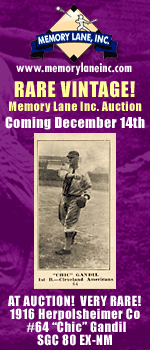5. Baseball's Oldest Old-Timer Turns 111
 Simply amazing!
Simply amazing!
Born in 1895--the same year as Babe Ruth--Negro Leagues player Silas "Si" Simmons on October 14 began his 112th year of life on planet earth. It doesn't get any more "vintage" than that! His photo at left was taken at his birthday celebration last Saturday.
Although researchers at the Society for American Baseball Research (SABR) have records in their files of some of Simmons early games, they had no idea until recently that the tricentenarian was still alive. While SABR records are incomplete for Negro and Minor League teams, there is little doubt that Simmons holds the record as the oldest professional baseball player ever. And he is still counting!
Chet (Red) Hoff who passed away in 1998 at the age of 107 is the longest-lived Major League ballplayer on record. Currently, the oldest living former Major Leaguer is Rollie Stiles, who turns 100 next month. Simmons easily outdistances them all.
When presented with a copy of a photograph of the 1913 Homestead Grays (shown below), Simmons identified himself as the second player from the right in the middle row. It is mind-boggling to realize that the two photos of Simmons used in this article were taken some ninety-three years apart and that Simmons' life spans three centuries (19th, 20th and 21st).

The team photograph shown was provided by Ryan Christoff, a SABR member and Negro League researcher based in Boulder, Colorado. According to Christoff, Simmons was in good company. On the same (middle) row in the team photo, third player from the left, is recently elected Hall of Famer Cumberland Posey. Posey became manager of the Grays in 1916, then built the team into one of the powerhouse franchises of black baseball, winning numerous pennants including nine consecutively from 1937-45.
Simmons grew up in a central Philadelphia row house. He was a left-handed pitcher who was signed by the nearby Germantown Blue Ribbons, a well-regarded team. In an interview for a recent article in the New York Times, he said that he started pitching for the Blue Ribbons at age 16 or 17 (1912 or 1913). Box scores and period articles from the Philadelphia Inquirer credit the 5-foot-10 Simmons with routinely striking out 10 or more batters while getting a hit or two each game. Researchers have uncovered box scores and game recaps with his name from many sources throughout the 1910’s and beyond.
Two box scores from 1926 show Simmons pitching for the New York Lincoln Giants of the Eastern Colored League. He also played at least one game for the Negro National League’s Cuban Stars in 1929.
"I had a good curveball and a good fastball," Simmons told the Times, adding that he was paid about $10 a game for his services.
Credit for "discovering" Simmons after all these years goes to David Lambert, another SABR researcher who is also a genealogist that works for the New England Historic Genealogical Society in Boston. Based on leads that Lambert uncovered while researching former Negro League baseball players for SABR, he was able to locate Simmons in a nursing home in Florida.
We are sure that all of our readers join us in wishing Si Simmons many more Happy Birthdays to come.


